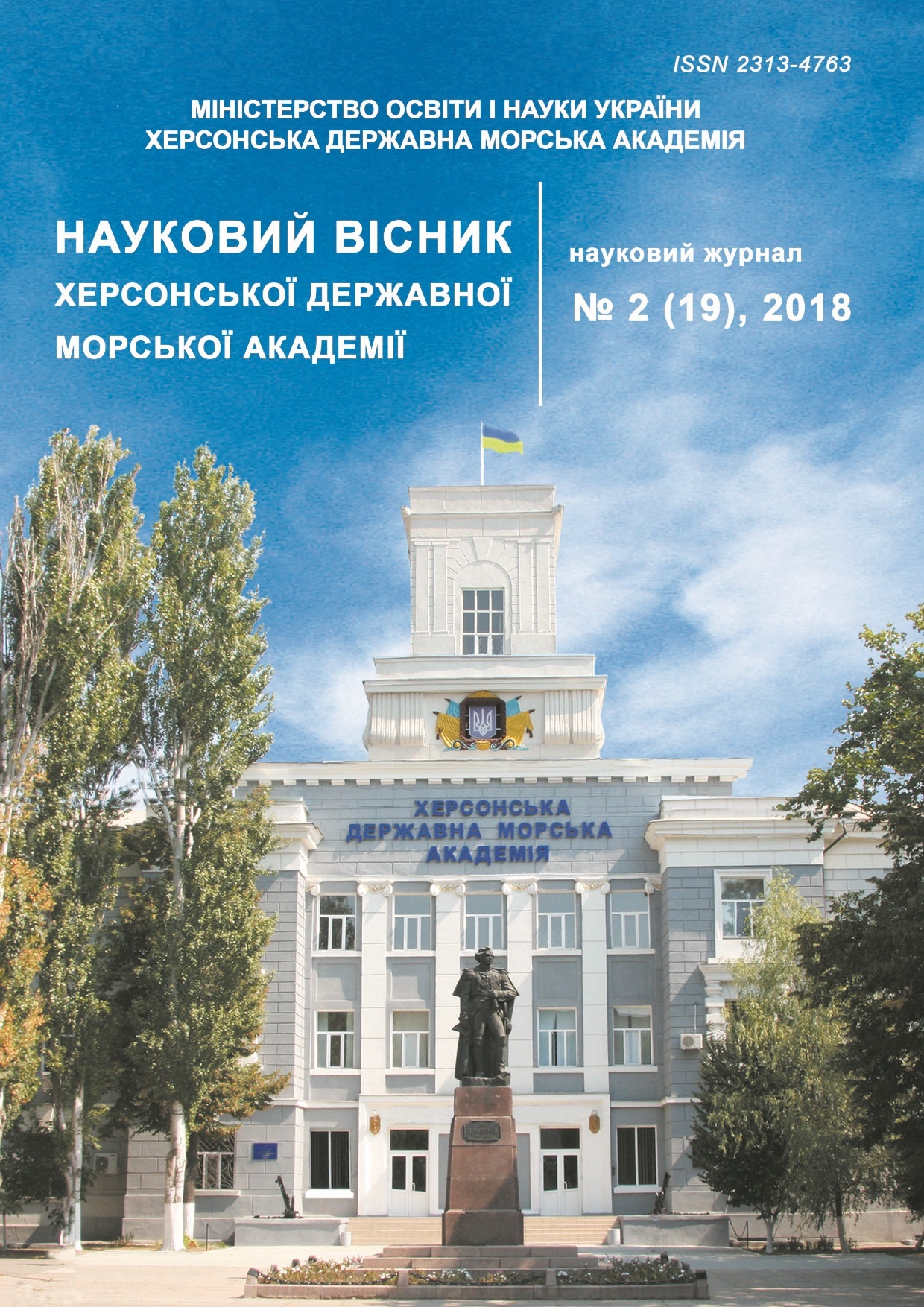THE PROJECT TASKS OF UNMANNED SELF-PROPELLED TETHERED UNDERWATER COMPLEX CREATION BASED ON THE SYSTEM APPROACH
Abstract
The rationale for a systematic approach to creating an unmanned self-propelled tethered underwater complex in the early design stages as an effective tool for carrying out underwater technical works is given. The basis of the systems approach is the equations of existence for the material, energy and information components. The interrelation and influence on these components of the fourth factor are considered, which are explained from the point of view of the functional expediency of creating elements of an unmanned self-propelled tethered underwater complex and is based on the equations of existence that illuminate the operational side of the tethered underwater vehicle. It was explained that not all operational features can be provided in numerical form, but there is only an opportunity to provide their description and determine the impact on the operation of the complex as a whole. As an example, the work of the complex at the anchorage with the calculation of time, which is a numerical functional component, is presented for examining a certain area of the bottom surface.
References
Створення універсальних транспортних суден і засобів океанотехніки: Монографія / С. С. Рижков, В. С. Блінцов, Г. В. Єгоров, Ю. Д. Жуков, В. Ф. Квасницький, К. В. Кошкін, І. В. Крівцун, В. О. Нєкрасов, В. В. Cеврюков, Ю. В. Солоніченко; за ред.
С.С. Рижкова. Миколаїв : Видавництво НУК, 2011. 340 с.
Блинцов В. С.? Магула В. Э. Проектирование самоходных привязных подводных систем. К. : Наукова думка, 1997. 140 с.
Autonomous vehicles in support of naval operations. National Research Council (U.S.). Committee on Autonomous Vehicles in Support of Naval Operations. Washington,
D.C. : National Academies Press, 2005. URL: https://www.worldcat.org/title/autonomous-vehicles-in-support-of-naval-operations/oclc/559891694
Блінцов В. С., Клочков О. П. Рівняння існування самохідної прив’язної підводної системи як оцінка можливості її створення. Підводні технології. 2016. Вип. 3. С. 25–30.
Steven W. Moore, Harry Bohm and Vickie Jensen. Underwater Robotics: Science, Design & Fabrication. Publisher: Marine Advanced Technology Edu; 1st edition, 2010. 770 p.
Управління успішними проектами створення складної техніки : монографія.
Г. В. Бабкін, В. С. Блінцов, Є. А. Дружинін, С. Г. Кійко, Н. Р. Книрік, К. В. Кошкін,
Д. М. Крицький, С. С. Рижков, С. О. Слободян, Т. А. Фаріонова. Миколаїв : Видавництво Торубари В. В., 2017. 336 с.
Milne P. H. Underwater Engineering Surveys. Gulf Publishing Company, 1980.
366 р.
Ястребов В. С., Соболев Г. П., Смирнов А. В. и др. Системы и элементы глубоководной техники подводных исследований : справочник. Л. : Судостроение, 1981. 304 с.
Witold Jacak. Intelligent robotic Systems: design, planning, and control. International Federation for Systems Research International Series on Systems Science and Engineering. Volume 14. Kluwer Academic Publishers, 1999. 310 р.
Rowinski, L. Pojazdy glebinowe. Budowa i wyposazenie. Gdansk : Przedsiebiorstwo Prywatne «WiB», 2008. 593 p.
Robert D. Christ, Robert L. Wernli. The ROV manual: a user guide to observation-class remotely operated vehicles. Butterworth-Heinemann, 2011. 320 p. URL: https://www.amazon.com/ROV-Manual-Observation-Remotely-Operated-ebook/dp/B006NVY3YY
Yasser M. Ahmeda, Omar Yaakoba, Bong K. Sun. Design of a New Low Cost ROV Vehicle. Jurnal Teknologi (Sciences & Engineering). 2014. Р. 27–32.
Vasantharaj R., Paravastu Vaidehi, Shobana M., Loganayaki S. Remotely Piloted Unmanned Underwater Vehicle Design and Control for Pipeline Maintenance. Proceedings of National Conference on Man Machine Interaction, 2014. Pages 40–43.
Underwater Robots. Motion and Force Control of Vehicle-Manipulator Systems. Springer, 2006. 265 р.
Нужный С. Н. Особенности проектирования кабель-тросов для малогабаритных самоходных привязных подводных аппаратов. Електромашинобудування та електрообладнання : республіканський міжвідомчий науково-технічний збірник. Одеса, 1998. Вип. 51. С.99–103.
Костенко В. В., Мокеева И. Г. Исследование влияния кабеля святи на маневренность телеуправляемого подводного апарата. Подводные исследования и робототехника. 2009. № 1 (7). С. 22– 27.
Szymak P., Małecki J. Control System of Underwater Vehicle Based on Artificial Intelligence Methods. Automation and Robotics. 2008. Р. 285–296.
Eirik Hexeberg Henriksen, Ingrid Schjølberg, Tor Berge Gjersvik. Adaptable Joystick Control System for Underwater Remotely Operated Vehicles. – IFAC (International Federation of Automatic Control) Hosting by Elsevier Ltd., 2016. Papers OnLine 49–23. Pages 167–172. https://doi.org/10.1016/j.ifacol.2016.10.338
Вельтищев В., Кропотов А., Челышев В. Автоматизация проектирования подводных телеуправляемых комплексов. Современные технологии автоматизации. 1997. № 2. С. 50–52.
Yung-Lien Wang & Chang-Yu Lu. Design and parameter estimation of a remotely operated underwater vehicle. Journal of Marine Engineering & Technology. 2012. 11:2. Р. 39–48. https://doi.org/10.1080/20464177.2012.11020265
Dudykevych, V., Oleksandr, B. Tasks statement for modern automatic control theory of underwater complexes with flexible tethers. EUREKA: Physics and Engineering. 2016.
Р. 25–36. doi: https://doi.org/10.21303/2461-4262.2016.00158
Блінцов О. В. Системи автоматичного керування рухом підводних комплексів з гнучкими зв’язками. Миколаїв : Національний університет кораблебудування імені адмірала Макарова, 2018. 251 с.
Вашедченко А. Н., Иванишин Б. П., Цыбенко Б. А. Уравнения существования подводных роботов. Сб. научных трудов. Николаев : НКИ, 1979. С. 17–24.
Клочков О. П. Оцінка можливості створення самохідної прив’язної підводної системи на основі рівнянь існування. Інновації в суднобудуванні та океанотехніці : матеріали VІІ Міжнародної науково-технічної конференції. Миколаїв : НУК, 2016.
С. 352–354.






